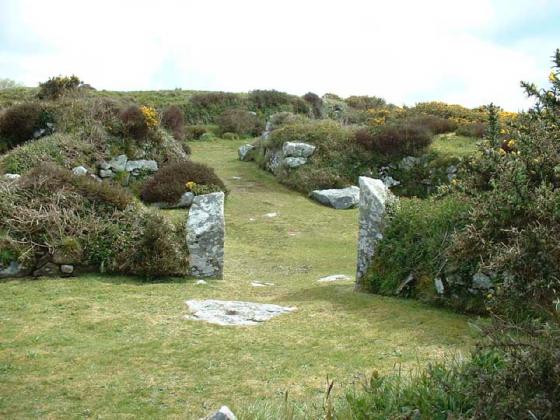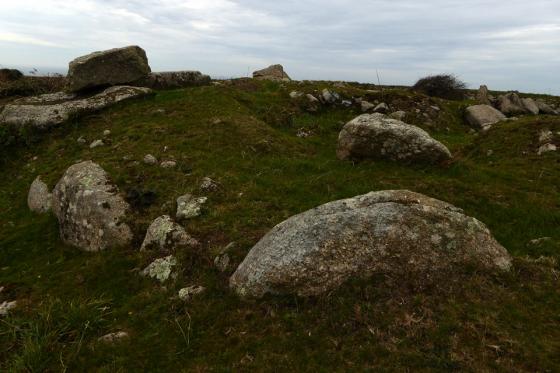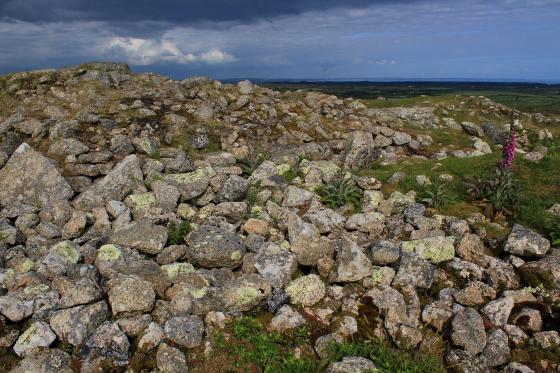
Open Source Environment agency LIDAR

Open Source Environment agency LIDAR

The overgrown northern slope of Lescudjack Hill.

The northern approach.

General view of the interior.

Looking out across Penzance and Newlyn from the fort interior.

A brand new view of the newly cleared Lescudjack Hill Fort, now fully open to the public.
© Alex Langstone 2008

Some remedial work has been undertaken... a vast improvement.

The c.1970 concrete wall which obscures much of the original rampart – whose bright idea was this I wonder?

View from the hillfort across Penzance towards Penlee Point

Lescudjack hillfort...sadly delapidated & overgrown.
In what would appear to be a victory for good sense, the town & district councils have stepped in at the eleventh hour to buy this historic site for the town of Penzance; hopefully this will ensure the preservation of what remains of this much abused antiquity. On visiting the site today to take the accompanying pictures, I was rather dismayed by the amount of dog-fouling present.
See BBC News web site for more details.
Concerns as Iron Age Fort Goes on Market – From This is Cornwall, 11:00 – 15th November 2004
An Iron Age hill fort is due to go under the hammer next month – to the delight of entrepreneurs but the concern of historians and locals. Lindsey Kennedy reports
Historians and a school have raised concerns about the sale of an historic hill fort in Penzance, which is to be put up for auction next month. Historians and a school have raised concerns about the sale of an historic hill fort in Penzance, which is to be put up for auction next month.
Lescudjack Hill Fort, the area’s largest Iron Age settlement, is for sale through Fulfords Estate Agents in Penzance, with a guide price of £28,000.
The estate agent said there had been “a lot of interest” in the site.
The area of land off Pendennis Road, Penzance, extends to around one hectare or 2.5 acres – and has breathtaking views over Penzance to Mount’s Bay and the Mousehole Peninsula.
In the sale particulars, the estate agents suggest the land is suitable for “general amenity, equestrian or perhaps parking on the quarry area to the south-east” subject to planning permission.
The historic site will be put up for auction on December 2 at the Novotel, Marsh Mills, Plymouth, unless previously sold,
Ian Addicoat, a local author and historian, is among those expressing concern about the pending sale.
He said: “Clearly it is imperative that such an historic and important site is maintained and preserved correctly”.
“I think if there were any plans to develop such an important site there would be an outcry, and I would be very surprised if the planners would allow it”.
He said the site was currently overgrown, adding: “I hope whoever takes it on appreciates its history and considers allowing it to be used as an amenity”.
“I’m not sure the public is aware of its significance. They probably think it’s a field with a nice view. But historians are certainly aware of what it represents”.
Historian and writer Craig Weatherhill, who mentions the hill fort in his book Belerion, said it dated back to around 300BC.
“It is extremely important to Penzance and over the decades it’s been treated pretty shamefully”, he said.
Hill forts were fortified settlements which began to appear in upland areas, especially in southern England.
They were often massive, complicated structures with surrounding ramparts and ditches. Some of them served as small towns and administrative centres, as well as fortifications at times of conflict.
Although the Penzance hill fort is overgrown, the site has never been properly explored and could reveal many archaeological secrets.
Mr Weatherhill added: “Some 15 to 20 years ago there was a proposal to do a hefty excavation but it came to nothing. It has never really been dug properly”.
“I would be delighted if local historical groups are successful, because they would have the well-being of the site at heart”.
Nikki Owen, headteacher of Penzance Infants School, which is close to the ancient site, said the news of the sale was “very disappointing”.
Two years ago children from the school gave some serious consideration to what they would like to see happen to the old Lescudjack Hill Fort site.
The children made the site their summer project and set about gathering names on a petition calling on the local councils to carry out some improvements.
Some 30 children from Year Two visited the then Mayor of Penzance, Ruth Simpson, and presented her with a 500-name petition calling for the site to be refurbished.
“It took us some time to track down the owner of the site, who turns out to be somebody in Newlyn,” Mrs Owen said.
“It is very disappointing that it is being sold off.
“I only hope that any future owner will develop it as a public amenity and show its historic significance.”
The fort is visible from Penzance town, particularly from the bus station. Unfortunately, you’d not recognise it as a fort, as it has housing built over most of it.
We walked up from the town centre on 20.6.09. There is an entrance to the fort from Castle Road, which gives on to an open grassed area. Most of the ramparts are outside of this public area, covered by either gardens or allotments. However, there are nice views over Mount’s Bay, as far west as Penlee Point.
After a walk around the interior, we had a quick walk around the residential streets on the north, but there wasn’t much to be seen. From here we went down the slope and joined the byway that runs along the north side of the hill. Here the lower slopes would have formed a natural defence, and they are still unbuilt upon, albeit overgrown with trees making viewing and photography difficult. We had a quick poke about, then onto a “proper” hillfort: Trencrom Hill.
The hill on the left-hand side is noted as having once had on its summit that “notable treble intrenchment of earth called Lescaddock Castle, that name referring to Cadock, earl of Cornwall, whose broad camp or castle of war it was, as tradition faith.” Some write the name, Lescudjack, and others, Lesgud-zhek; the latter explained by Borlase as the “Castle of the Bloody Field.” The provincial name of it was “The Giant’s Rounds.” The only portion of this fortification now remaining is a large raised circular mound, enclosing several fields. The mound is nearly perfect, and there is a pathway outside it which was probably the site of the original intrenchment.
From Rambles in Western Cornwall by the Footsteps of the Giants, by J. O. Halliwell-Phillipps (1861).





















































































































































































